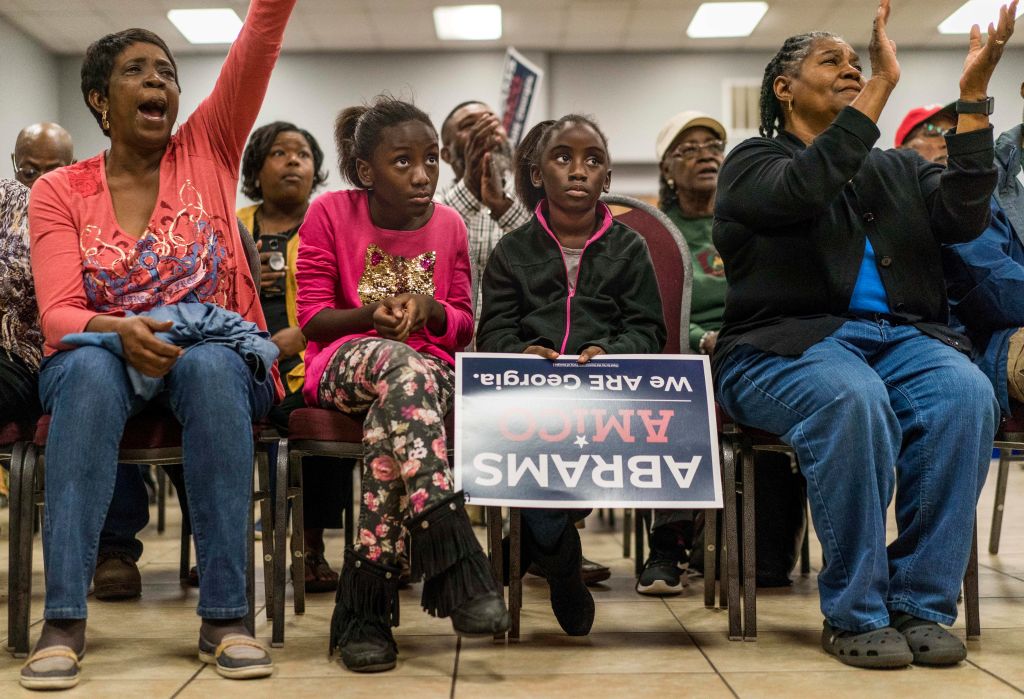The History Of Voter Suppression

People march across the Edmund Pettus Bridge with placards bearing the image of the late U.S. Rep. John Lewis, for whom the most recent voting rights bill is named, during commemorations for the 57th anniversary of “Bloody Sunday” on March 6, 2022, in Selma, Alabama. | Source: Brandon Bell / Getty
Wednesday will mark the fourth anniversary of John Lewis’s passing. Lewis, a revered civil rights leader, dedicated his life to advancing equal rights and justice for marginalized communities in America. One of his enduring legacies is the advocacy for The John Lewis Voting Rights Advancement Act, designed to strengthen voting rights by expanding governmental oversight to combat discriminatory voting practices such as voter suppression. This legislation proposes new criteria to mandate preclearance from the Department of Justice or U.S. District Court for changes impacting voting rights.
Since August 2023, progress on the John Lewis Voting Rights Advancement Act has stalled, with the bill awaiting approval by the House Committee on Judiciary as of September 2023. The bill is critical as voter suppression remains a large concern, evolving through tactics such as voter ID laws and gerrymandering, which disproportionately affect vulnerable groups including low-income individuals, minorities, and LGBTQIA+ members.
Some politicians are fighting to push the bill forward in honor of Lewis’ legacy. In March, President Biden urged Congress to pass this vital legislation, emphasizing the fundamental importance of voting rights in democracy.
As we reflect on Lewis’s remarkable contributions, it is crucial to acknowledge the historical impact of voter suppression on Americans, highlighting persistent efforts to disenfranchise specific groups from participating in elections.
Throughout U.S. history, access to voting rights has been fiercely contested, with systemic barriers targeting racial minorities, women, the poor, and other marginalized communities.
From the Reconstruction Era’s violent efforts to suppress Black voters to the suffrage movements of the early 20th century and the Civil Rights Movement’s battles against discriminatory practices in the mid-20th century, the struggle for fair and inclusive voting rights continues to shape American democracy.
Between 1863 and 1877, Black Americans achieved significant milestones with the ratification of the 13th and 14th Amendments, which abolished slavery and granted citizenship to those once enslaved. However, this period was marred by political violence aimed at reinstating white dominance.
One egregious example was the Opelousas Massacre of September 1868 in Louisiana, where white men in St. Landry Parish killed approximately 250 mostly Black Americans, CNN noted. This brutal act aimed to suppress Black voter turnout following Louisiana’s ratification of a state constitution that granted Black men the right to vote earlier that year.
Voting discrimination continued after the ratification of the 15th Amendment.
Despite the 15th Amendment’s ratification in 1870, which prohibited states from denying voting rights based on race, many former Confederate states enacted voter qualifications such as poll taxes and literacy tests. The infamous grandfather clauses exacerbated racial inequalities in voting rights by permitting white voters to maintain their voting privileges based on ancestry, specifically excluding many African Americans whose ancestors were enslaved. These clauses typically restricted voting eligibility to individuals whose male ancestors were qualified to vote prior to 1867, effectively disenfranchising African American men who were previously denied the right to vote, according to the National Archives.
In the landmark case of Guinn v. United States, the U.S. Supreme Court unanimously ruled that Oklahoma’s grandfather clause, exempting certain voters from literacy tests, violated the 15th Amendment. While this decision had limited immediate impact as states found other ways to disenfranchise Black voters, it bolstered the National Association for the Advancement of Colored People (NAACP) as a leading advocate for voting rights.
Between 1840 and 1920 women were barred from voting in the U.S. Activists and reformers spent nearly a century fighting to secure that right, facing numerous challenges along the way. Internal disagreements over strategy often posed significant threats to the movement’s progress, History highlighted. The 1920 ratification of the 19th Amendment eventually granted women the right to vote, but some continued to encounter barriers. Women of color faced discrimination at the polls, alongside Native Americans, Asian Americans, and Hispanic Americans who encountered barriers such as English literacy tests and citizenship requirements.
Voter suppression persisted during The Civil Rights Movement of the 1950s and 1960s which brought national attention to discriminatory voting laws. Led by figures like Dr. Martin Luther King Jr., activists fought against these injustices. The Voting Rights Act of 1965 was a pivotal legislative response, eliminating literacy tests and other discriminatory practices while mandating federal oversight of election procedures in jurisdictions with a history of racial discrimination.
Today, America still has work to do to ensure voting is a right for all. The history of voter suppression in America is a complex narrative of legal and extralegal measures designed to limit access to the ballot box for marginalized groups. While significant strides have been made through legislative reforms and grassroots activism, challenges persist. Recognizing this history is crucial for understanding ongoing debates about voting rights and ensuring that all Americans can exercise their democratic right to vote freely and fairly.
SEE ALSO:
Reports Of Voter Suppression Mar Mississippi Election In Majority Black County
The post The History Of Voter Suppression appeared first on NewsOne.





